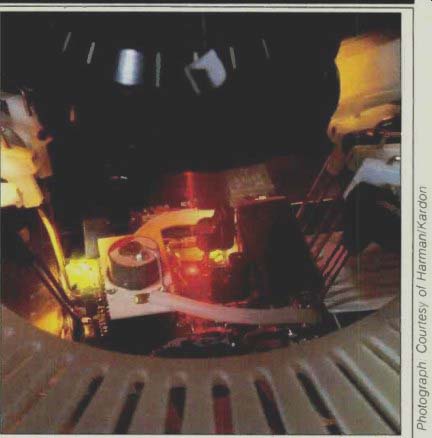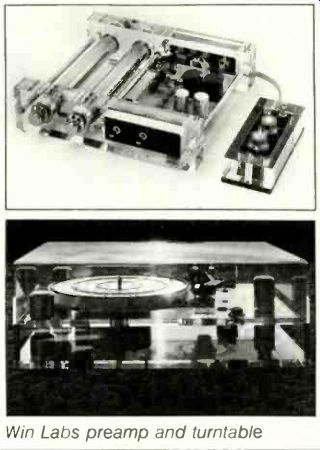GARDEN OF UNEARTHLY DELIGHTS

--While test signals are fed to this custom, thick-film hybrid circuit (used in the Citation XX amp), a laser trims its component values to 0.03% accuracy, for minimum distortion.
Every year at the Consumer Electronics Shows, the mind boggles at the sheer numbers of new products that are displayed.
There is such a vast array of new equipment that, regrettably, full coverage is just not feasible. Thus, I wander through this audio garden of delights and pick what I feel are some of the most interesting and worthwhile components. Last month I reported on several interesting new loudspeakers shown in Las Vegas at the WCES, and herewith some other models worth an audition.
Magneplanar introduced their MG-III loudspeaker, an imposing unit standing 6 feet high and nearly 2 feet wide, but only 2 inches deep. This is a three-way system whose bass and midrange section utilizes Magneplanar's well-known planar magnetic principle. The company states this speaker has the largest bass/midrange driver they have ever designed, with bass response extending into the 30-Hz range. At 3 kHz, this driver crosses over to a 5-foot-long bipolar ribbon tweeter. Frequency response is rated at ±4 dB from 37 Hz to 40 kHz. This 8 ohm speaker can handle amplifiers up to 200 watts, and it has provisions for biamplification. The demonstration I heard offered a very clean, exceptionally smooth sound, with good definition and excellent imaging. Bass response was quite good, but some people might want to add a subwoofer for more extension and impact. The MG-III is priced at $1,950 a pair.
In the Sound-Lab room was a demonstration of their new 57 1/2 in. H x 29 in. W x 6 1/2 in. D electrostatic loudspeaker, Model A-2X. This was a good-sounding unit having all the desirable characteristics associated with electrostatic speakers-very clean and highly detailed, with exceptional transient response. However, the item that intrigued me was a prototype electrostatic subwoofer! Approximately the same size as the A-2X, it produced a nice, full bass sound that was notable for its clean delineation, low coloration, and lack of overhang. With further development, with a view towards more impact, this could have considerable potential.
Staying with electrostatic loudspeakers, a Stax system was used in the impressive Citation demonstration.
This was one of the larger rooms, and Citation (a division of Harman/Kardon) had gone to considerable trouble and expense to treat the room with Sonex in a semi live-end/dead-end fashion.
Dr. Matti Otala, designer of the Citation XX 250 watt/channel amplifier and the XXP preamplifier, was on hand. It is always such a pleasure to meet this brilliant scientist. He discussed some of the updating and refinements recently implemented in his Citation designs. Dr. Otala then demonstrated the system with some splendid Swedish choral recordings, and the reproduction was really quite beautiful-open, transparent, highly detailed, and certainly one of the nicest sounds at the show.
One interesting aspect of Citation's technology is their use of a custom, thick-film hybrid circuit in the XX. A computer system trims it to 0.03% accuracy by feeding it test signals, measuring its output, and trimming its components with a laser till the output is precisely right.
One can always expect interesting new speaker designs at the B & W exhibit. This year they demonstrated their new DM2000 and DM3000 speakers, specifically designed to cope with the digital dynamics of the Compact Disc. The DM2000 is 32 inches high, and the DM3000 stands 38 inches high; both are 12 1/4 inches wide and 15 1/4 inches deep. The DM2000 employs a passive bass radiator, an active 6 1/2-inch bass/midrange driver, and a 1-inch TX26 tweeter. The DM3000 has the same driver complement except for the addition of another active 6 1/2-inch bass/midrange driver.
Crossovers for both units are fourth order Butterworth. The in-line drive units are electronically corrected for minimum inter-unit time delay.
There is much new technology here.
The new drivers are made in the B & W factory and employ Kevlar cones, all designed and optimized using B & W's laser interferometer. The back of each loudspeaker is triangular, and this design is said to help reduce standing waves. At 87 and 89 dB SPL at 1 watt/1 meter respectively, the DM2000 and DM3000 are fairly efficient.
As you might expect, the imaging of these new speakers is in the B & W tradition-which is to say, outstanding and with precise, stable localization.
Treble and midrange are very clean, with good launch into the listening space. Bass is clean and well defined, if a bit on the weighty side. Most important, these characteristics do not deteriorate at high levels. I did not feel the B & W demo material was as good as it usually is, but it certainly served to emphasize that these speakers are ready for the dynamics of digital sound. However, if someone gets too enthusiastic about high SPL, both speakers are equipped with overload protection circuitry.
Several amplifiers at the show were of more than passing interest. One was a new tube design from Counterpoint, their 50-pound SA-4. This is a mono amplifier and, of course, is sold as a pair ($4,495) for stereo. The SA-4 uses direct coupling (with no output transformer, a la the Futterman amplifier), only 26 dB of feedback, and a dual triode-differential input stage. There are no electronic limiters to restrict voltage or current output. The SA-4 employs eight 6LF6 output tubes. There is a meter to measure bias and tube performance and controls for bias adjustment. The power-supply transformer is rated at 1 kW. A power output of 100 watts into 8 ohms was claimed at the show but has since been upped to 140 watts into 8 ohms. Distortion is rated at less than 0.1% at full power.
This appears to be a significant new tube amplifier, and what I heard sounded very good indeed, with excellent transient response and better bass detailing than is the case with many tube amps.
Another amplifier creating quite a bit of interest was the Robertson Audio Sixty Ten. Rated at 200 watts/channel into 8 ohms, it is claimed to produce up to 1,600 watts into a 1-ohm load.
Each channel is modular and can be entirely replaced in a matter of minutes. No details of the power supply were given, but it was claimed that it is big enough for an output of 46 amperes. Frequency response is 0.5 Hz to 250 kHz. This Sixty Ten amplifier is priced at $2,995.
(Editor's Note: Two amplifiers which caught my eye were the Streets Model 950 and the Electron Kinetics Eagle 7A, which last is John Iverson's new baby. The Streets uses no V-I limiters in its output stage and has a wide band, low-feedback design, with a recommended minimum load of 2 ohms. More important is the Streets 950's ability to deliver high levels of current--60 amps peak and 15 amps continuous. The Eagle 7A is a dual-mono design, also of wide bandwidth; flat at d.c. and-3 dB at 300 kHz. Power output from this beefy fellow is 300 watts continuous into 8 ohms with 1.4 horsepower, peak, per channel; at 3 ohms, 1,600 watts is available. -E.P )

--Win Labs preamp and turntable
Last month I promised to tell you about the brilliant new technology in the design of Sao Win's new moving coil cartridge, preamplifier, turntable and arm.
As I am sure you are aware, most audiophiles seem to have a predilection for belt-driven turntables rather than direct-drive types. Although direct-drive turntables have much more accurate rotational speed and stability, audiophiles claim that they also have too much vertical rumble, which superimposes noise on the reproduced sound. This has been a controversial point for some years.
Enter Sao Win and his SEC (servo encoder control) turntable. First off, I must comment that this is visually the most beautiful turntable extant. It is made of sparkling, half-inch thick, crystal-clear plexiglass. It has a special three-point suspension, with springs fabricated and combined with a new type of damping compound for a spring rate of less than 3 Hz. The SEC-10 motor is a d.c. brushless, multi-slot, multiple-pole unit free of cogging effects. It rests on a motor bearing which is internally suspended on a magnetic field. The turntable speed is referenced to a 1.048-MHz quartz crystal. Speed is monitored by an infrared optical encoder which samples speed 600 times during each revolution of the platter, feeding its data into a digital servo system to regulate the speed. Wow and flutter is rated at ±0.003% (DIN) and rumble at -78 dB. The turntable will be fitted with a' double-tube pantograph arm system with virtually no tracking error.
The Win Jewel moving-coil cartridge employs much new technology. The stylus, the Win-Vital, has a tip radius of 0.006 x 0.040 mils. Tip mass is 11 micrograms, and the stylus tip is super-polished in a plasma bath to a finish of 40 angstroms. The cantilever is a complex structure made of alpha alumina (essentially the same as synthetic ruby or sapphire). Tracking force is 1.2 to 1.5 grams.
The Win phono preamplifier is sold only in combination with the Win Jewel cartridge. Here again, the unit is encased in plexiglass. It uses a specially manufactured low-noise integrated circuit that has a super-regulated and controlled power supply with a bipolar cascode input. Because of its extremely wide bandwidth (d.c. to 6 MHz) and high gain, the preamp IC is housed inside a chromed copper tube, using waveguide design principles to eliminate r.f.i. Controls are activated by the use of photoelectric cells with operational-amplifier-controlled light-emitting diodes-in other words, no potentiometer wiper blades or conductive plastic. There is a high-level input in addition to the phono input which, needless to say, has impedance optimized for the Win cartridge. The RIAA equalization is flat, ±0.5 dB, from 15 Hz to 20 kHz. Output of the system (cartridge and preamp) is 7.75 mV at 5 cm/S recorded velocity. The preamplifier's THD is rated at less than 0.001%, and phase linearity is claimed to be ±2° over the entire audio spectrum.
Rise-time is a super-fast 580 nS. Together, the Win Jewel cartridge and preamplifier cost $1,000. An optional remote control for the preamp, with a muting switch plus volume and balance controls, will be available for about $150 to $200. As you can see, this is very likely the most sophisticated phono playback system currently available.
(adapted from Audio magazine, Bert Whyte)
= = = =